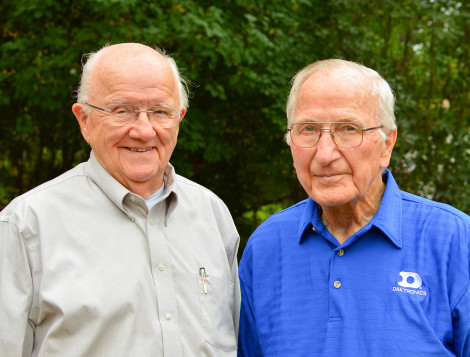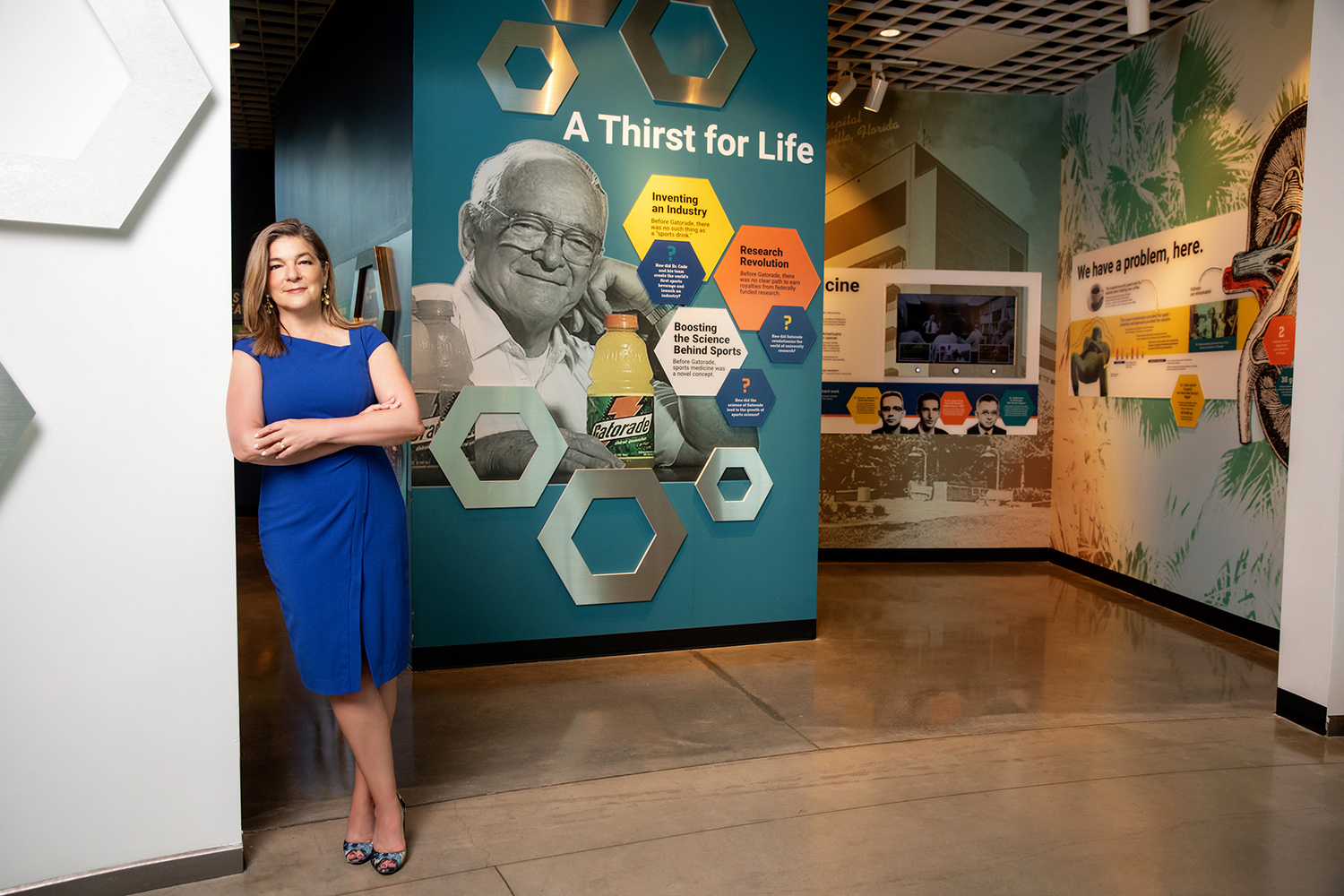
Gatorade legacy whets daughter’s thirst for 'inventivity'
Nearly 60 years after her father’s invention made a splash on the football field, Phoebe Cade Miles and her Cade Museum staff in Gainesville, Florida, continue Dr. James Cade’s legacy by encouraging 'inventivity' for all Americans through creativity, courage, resiliency, and confident humility.
15 min read
Each month, our Journeys of Innovation series tells the stories of inventors or entrepreneurs who have made a positive difference in the world. This month, Bill Lincicome's story focuses on Phoebe Cade Miles and the work her Cade Museum staff do to perpetuate her father's legacy of invention, creativity, and community-driven innovation.
Do you know an innovator or entrepreneur with an interesting story?
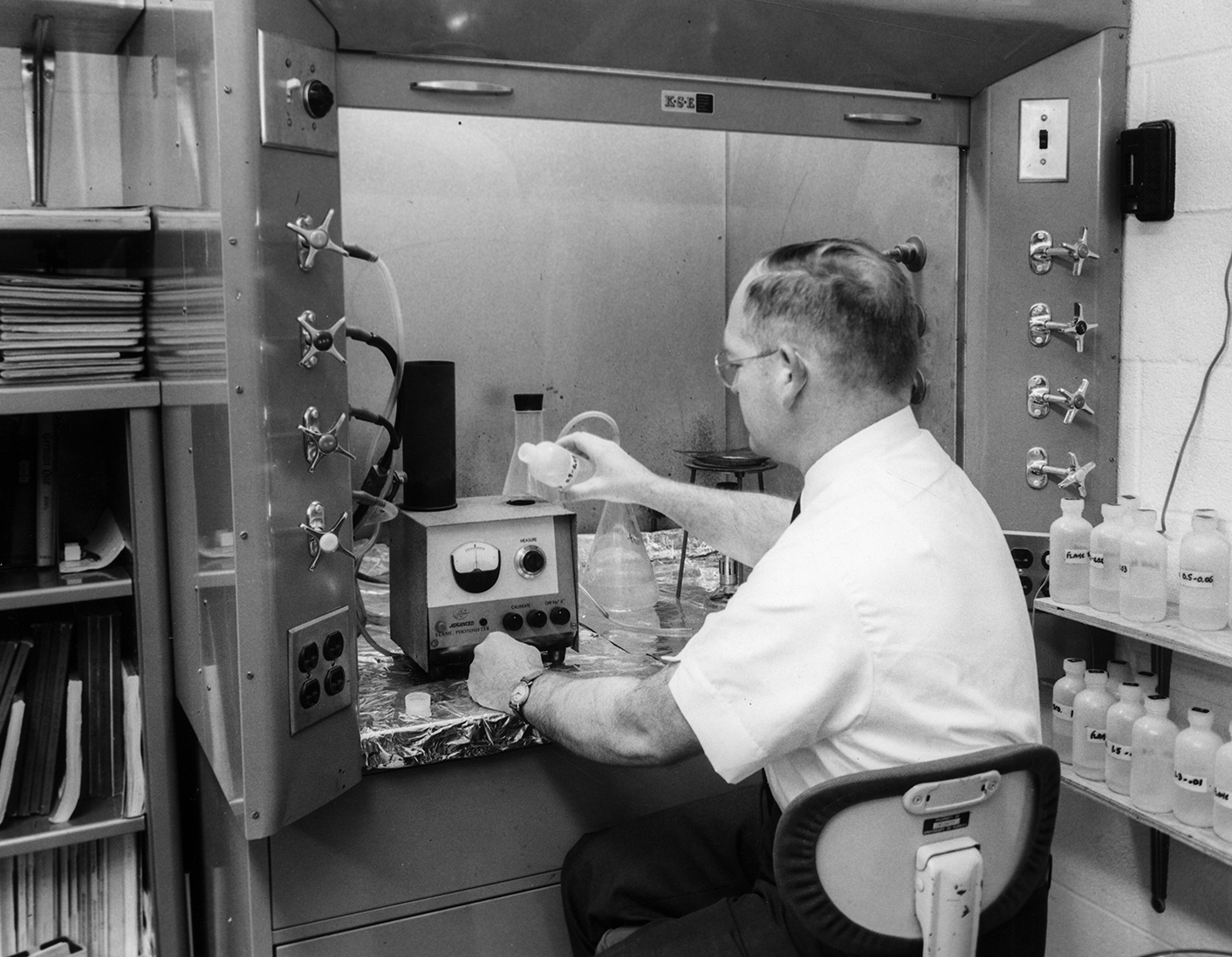
Dr. James Robert Cade working in his laboratory at the University of Florida during the 1960s.
(Courtesy of the Cade family)
For Phoebe Cade Miles, growing up as the daughter of Dr. James Robert Cade in the 1960s and 1970s was a lot like being in the movie “Chitty Chitty Bang Bang.” She, her five older siblings, and neighborhood kids would wait excitedly for Phoebe’s father to bring home something fascinating, such as a new telescope or even a three-legged dog. Even berry-picking outings at their Gainesville, Florida, home were adventures. After picking wild berries and plums, father and daughter rode their bikes home and brought their fruity bounty into the Cade kitchen to make jam. Sometimes the homemade jam turned out well. One time, Phoebe said, the jam didn’t quite gel. She and her dad asked each other why didn’t it gel? Was it too acidic? What do we do with it now?
The answer to the third question was sweet and easy — syrup for ice cream. However, learning the lessons her father taught her in their kitchen “laboratory” were even sweeter.
“I learned a lot of chemistry without knowing it was learning chemistry,” she said. “It was super fun. [I’m] soaking this stuff in without even knowing it.”
This began a lifelong journey of what Phoebe calls 'inventivity,' or a combination of invention and creativity. A key moment in her journey began when her dad asked a question in 1965. At that time, Dr. Cade was an assistant professor of internal medicine in the University of Florida (UF)’s renal division. He noticed football players seldom urinated during practices in the hot, humid Gainesville summers.
“Why don’t football players wee-wee during a game?” Dr. Cade asked.
At that time, dozens of dehydrated Florida Gators regularly ended up in the UF’s infirmary. Phoebe said her dad was having coffee with his friend Dewayne Douglas, a hospital security guard and Gators assistant coach, who noted players lost 15 pounds or more of fluids during practices and games. Dr. Cade and his team of researchers, Dr. H. James Free, Dr. Alejandro de Quesada, and Dr. Dana Shires, set out to fix this problem by creating a drink to replenish the electrolytes the players lost during their strenuous workouts.
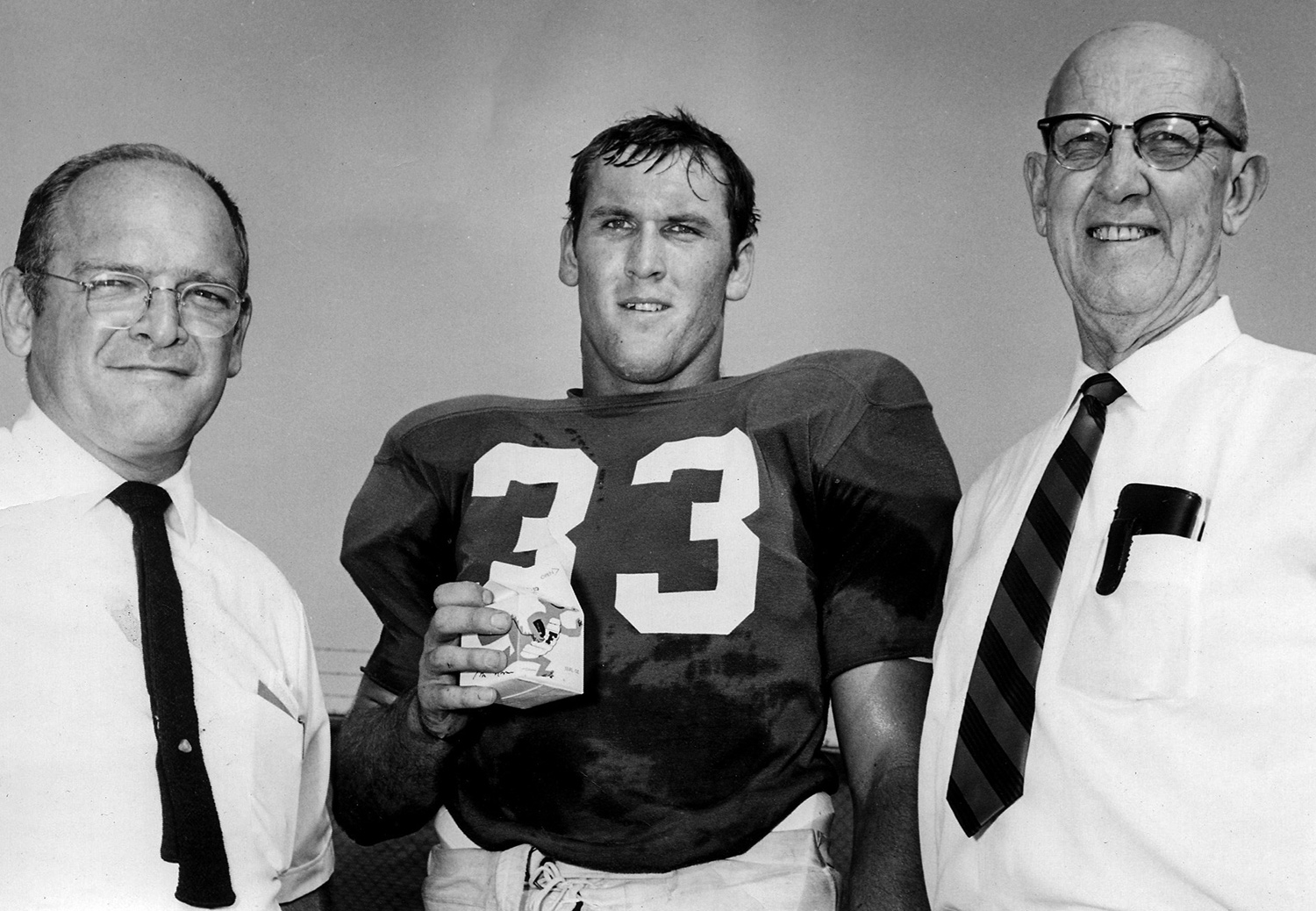
University of Florida Gators running back Larry Smith, center, drinks Gatorade while being flanked by Dr. Cade, left, and Gators head coach Ray Graves, right.
(Courtesy of University of Florida)
That drink would become Gatorade.
The initial creation of water, salt, sodium citrate, fructose, and monopotassium phosphate might have been thirst quenching, but it wasn’t tasty. Three doctors who sampled the first batch in 1965 quickly spat it out. Gators lineman Larry Gagner’s review was even less forgiving. Spitting out the drink, he declared it tasted like a certain bodily waste and dumped the rest of it on top of his head.
Enter Mary Cade, Dr. Cade’s wife. When her husband related the beverage’s revolting reviews, Mary’s advice was simple: lemon juice. Dr. Cade took his wife’s advice, adding lemon juice and cyclamate, a type of artificial sweetener, to the existing concoction. The new version was tested during a Gators’ scrimmage. After seeing positive results, Gators’ head coach Ray Graves ordered a batch made for a game against the Louisiana State University Tigers on October 2, 1965, which the Gators won 14-7. The most famous test of Gatorade came in the 1967 Orange Bowl game in which the Florida Gators defeated the Georgia Tech Yellow Jackets 27-12. The difference in the game was simple:
“We didn’t have Gatorade,” said Georgia Tech coach Bobby Dowd.
Phoebe said her father saw Gatorade’s potential going far beyond the football field. He believed his invention and others like it could save lives and inspire a community of creativity in America.
Nearly 60 years after her father’s invention made a splash on the football field, Phoebe Cade Miles and her staff at the Cade Museum for Creativity & Invention in Gainesville work tirelessly to steward her father’s legacy by encouraging innovation for all Americans, especially underserved communities through what Phoebe calls 'inventivity.'
The Cade Museum was founded in 2006, a year before Dr. Cade’s death. Shaped like a Fibonacci spiral, the building opened in 2018. Phoebe said she and her father wanted to inspire innovation in collaborative communities across America.
The word 'inventivity' was coined about a dozen years ago by Patty Lipka, a Cade Museum staff member, when the staff was trying to come up with a fun theme for an annual event at the museum.
“'Inventivity' is something we think is so important that we had to invent a word to describe it. It’s creativity and invention, too. And we think it's not just a nice way for kids to spend an afternoon, but it's essential to the future of our nation because it's a mindset and it's a mindset of how does an inventor think?”
Phoebe said 'inventivity,' which received trademark protection in May 2022, is comprised of three character traits:
The courage to go after complex problems.
Resilience in the face of setbacks because failure can be just as, or even more, useful than success.
- Confident humility, meaning you're confident the solution is out there. You're confident in your role, but you also have the humility to know a key insight may come from a completely different, unexpected source.
Sitting in a re-creation of her father’s lab in the Cade Museum, Phoebe said creativity was all around during her childhood.
“My dad was a Renaissance man,” she said. “He was a poet, a musician. He restored cars. (Dad) did make gravy and he did make jam.”
Whether in the kitchen, the laboratory, or in the community, Phoebe said her father was very much a scientist, always testing different ideas. He also had the ability to see intelligence and potential in everyone, despite living in the segregated Deep South of the 1960s.
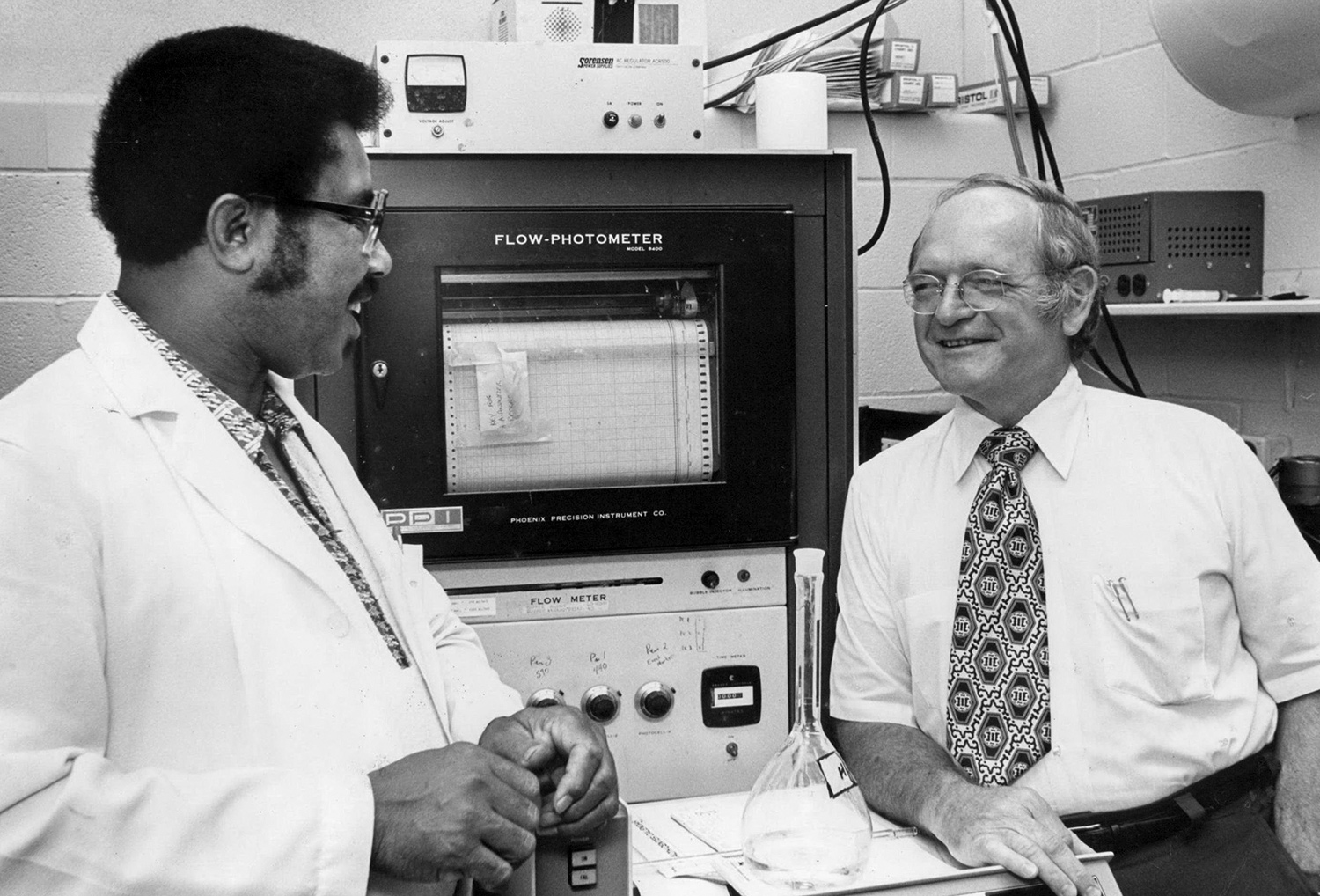
Dr. James Robert Cade, right, speaks with his laboratory technician, Kelly Campbell, in the 1960s. The pair worked together for nearly 40 years.
(Courtesy of the Cade family)
Pointing to a black-and-white photograph of Dr. Cade and a lab technician in deep discussion, Phoebe relayed that the lab tech, Kelly Campbell, who is Black, came to her father looking for work.
“He wasn't a lab tech,” said Phoebe. “My dad said ‘I’ll hire you. I need a lab tech. I’ll train you.’ I do not know what his education was, but he did not have a traditional [scientific research-based] education.”
Stories like Campbell’s show the success that can come through determination and opportunity. Phoebe said Campbell worked for her father until illness forced Dr. Cade to quit coming into the lab in 2004. That ability to see potential in everyone is now central to the Cade Museum’s work.
In one of the museum’s educational outreach programs, children in underserved schools learn about Black innovators who found success in the face of oppression and segregation. Students learn about Madam C.J. Walker, possibly the first woman to become a self-made millionaire with her hair care products for Black women, and Thomas L. Jennings, a Black man from New York who patented a method of dry scouring that was the predecessor to modern dry-cleaning in 1821. Jennings used proceeds from his invention to help fund growing abolitionist and civil rights movements in New York City.
“These examples succeeded despite hardship, despite discrimination, despite racism,” Phoebe said. “They were resilient, and because they loved their communities, they used these ideas to help their community.”
Aside from the historical lessons, the museum is leveraging a popular social media trend to connect with students.
“One thing we've been testing out is a phrase: ‘So, you want to be an influencer? Become an inventor! They're the original influencers.’”
Beyond its educational programs, the Cade Museum also hosts the Cade Prize, an annual event where inventors showcase their ideas relatively early in their innovation journeys. Not all of them have working prototypes or a patent at this point, Phoebe said. The main idea of the Cade Prize, she said, is to find the next big idea.
“To find the next Gatorade,” she said. “Not just a sports drink; to encourage people that have that idea. To take the next step and try to do something with their idea."
Phoebe said the museum invites contestants to teach an outreach class to inspire younger innovators-to-be. She mentioned Rodrigo Griesi, the founder of Neptunya Ocean Power, who won last year’s Cade Prize, as a prime example of an innovator who could show students how he used science to develop his “Octopodz” invention, a floating turbine used to create renewable energy.
“This is my lifetime dream, to live and work in a country that attracts, supports, and inspires innovation,” said Griesi, who moved to Florida eight years ago to pursue his dream. The same week that the Brazilian-born Griesi won the Cade Prize, he and his family became U.S. citizens.
The courage Griesi and other innovators display goes hand-in-hand with another inventivity characteristic – resilience.
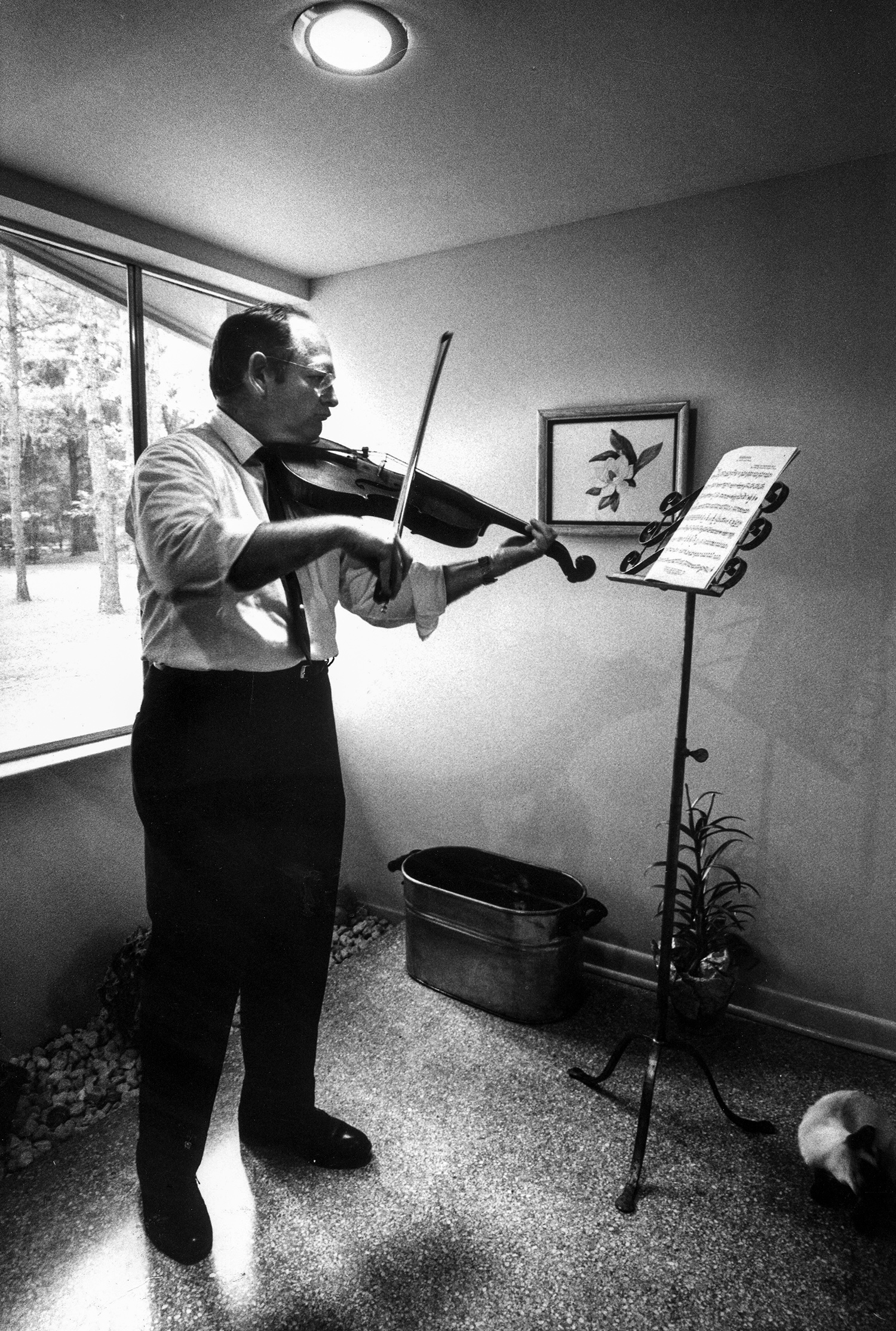
Playing the violin, restoring cars, and making homemade jams were just a few therapeutic activities Dr. James Robert Cade engaged in when he faced hardships in his personal and professional life.
(Courtesy of University of Florida)
Phoebe said her father, who had a D- average in high school, was often in trouble. Fortunately, she said, his violin teacher and his pastor saw his potential and encouraged and mentored him. That mentorship and musical ability instilled a sense of resiliency that Dr. Cade used throughout his life. Phoebe said her father would often play the violin when he was trying to work through a difficult problem, or if a patient died.
It was Dr. Cade’s most vulnerable patients that came first in his mind when he realized the success of his invention, Phoebe said.
“I think the thing about the Gatorade story that people don't remark about is they focus solely on sports and the Gators and rah-rah-rah and winning football,” she said. “But what all of the doctors were most proud about — every single one, my dad and all of his grad students — was the fact that the second test subjects were babies at the hospital. Immediately after [the Gators] won the first game, my dad thought, ‘This is going to help the babies that are hospitalized for severe dehydration.'”
The human body requires the right amount of salt to maintain water. Losing sodium through sickness can cause death by dehydration. Infants are particularly vulnerable to dehydration.
“Gatorade was the first select oral rehydration beverage that allowed the body to replace sodium very quickly,” she said. “They were all experts in how salt [is used by] the body. It could have only been invented by a kidney doctor.”
After the success of the initial batches in 1965, Dr. Cade and his staff quickly ran out of the glucose needed to produce additional batches of the drink. He turned to the University of Florida for help. The outcome of this meeting tested the resiliency of Dr. Cade and his staff to make Gatorade a reality.
“My dad was not an entrepreneur,” Phoebe said. "[He] tried to give this to the University of Florida, saying ‘This is helping people. We can't produce this in the laboratory anymore. Please take this.’ They said, ‘We are not in the soft drink business.’”
Despite the setback, Dr. Cade’s students encouraged him not to give up, Phoebe said. A scientist friend of one of Dr. Cade’s students put up money so the research team could apply for a patent. By the next year, other scientists had joined the team, including Dr. Kent Bradley, who had recently transferred from UF to Indiana University (IU).
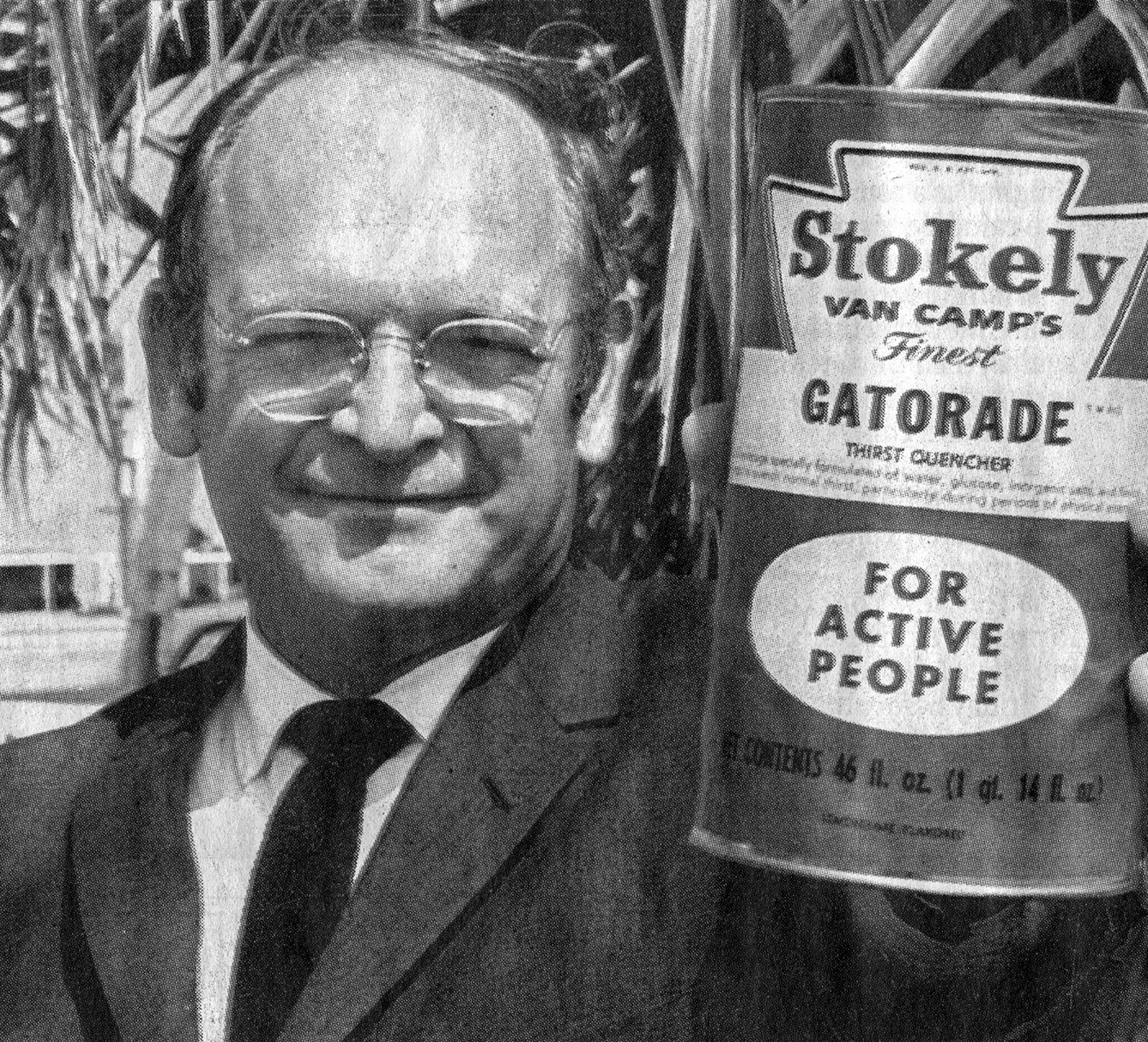
After the University of Florida refused to take over production of Gatorade, the research group that invented the hydration drink took it upon themselves to market the product, finding success with the Stokely-Van Camp food company.
(Courtesy of the Cade family)
In 1966, Dr. Bradley pitched Gatorade to Alfred J. Stokely, CEO of the Stokely-Van Camp food company, during a Christmas party. Stokely initially declined, but Dr. Bradley showed up the next day at the company’s lab in Indianapolis with a Mason jar of Gatorade.
"He told the secretary, ‘I have an appointment. He’s expecting me.’ He went in and sold the idea. It never would have happened without him,” Phoebe said.
Dr. Shires, who also transferred to IU from UF, was the next to step up on the Gatorade team. He offered to sell Gatorade to Stokely-Van Camp for $1 million. The company refused, but Shires’ skill and persistence resulted in the Gatorade Trust, where the development team would receive a 5-cent royalty for each gallon of Gatorade sold. By 2015, more than $1 billion in royalties had been paid to beneficiaries and their families.
“Dr. Shires had this incredible negotiation skill set,” Phoebe said. “They didn't want to pay $1 million, so they negotiated royalty structure on every bottle sold. They didn't cap it. They never thought it was going to make enough money to even think about that, so that contract is still in place [and] it’s the best contract ever.”
Gatorade’s burgeoning sales in the next few years began to catch the attention of UF officials. The university took particular notice after Kansas City Chiefs head coach Hank Stram, who was friends with UF coach Ray Graves, was the first NFL coach to have Gatorade on his team’s sidelines. In 1970, the Chiefs defeated the Minnesota Vikings, 23-7, to win Super Bowl IV.
Phoebe recalled Dr. Cade’s indignation after UF demanded the royalties to Gatorade in 1971.
“The university said, ‘We own it because we paid $46,’ and my dad was like ‘Up your nose with a rubber hose.’ He actually said that,” she said.
After a 31-month legal battle, the university agreed to receive 20% of the royalties. Phoebe said that experience opened her eyes to the collective effort it takes to become a successful innovator and gave her a front-row seat to a change in patent law. In 1980, Congress passed the Bayh-Dole Act, which allows university researchers like her father to benefit from their research.
“I actually feel very, very privileged to have been a part of that, even as awful as it was then, because patent law needed to be updated to reflect a modern research university. The inventor gets royalties, and the university gets royalty. It's like a win, win, win,” she said.
The Cade Museum wants to see children and other underrepresented entrepreneurs win, too.
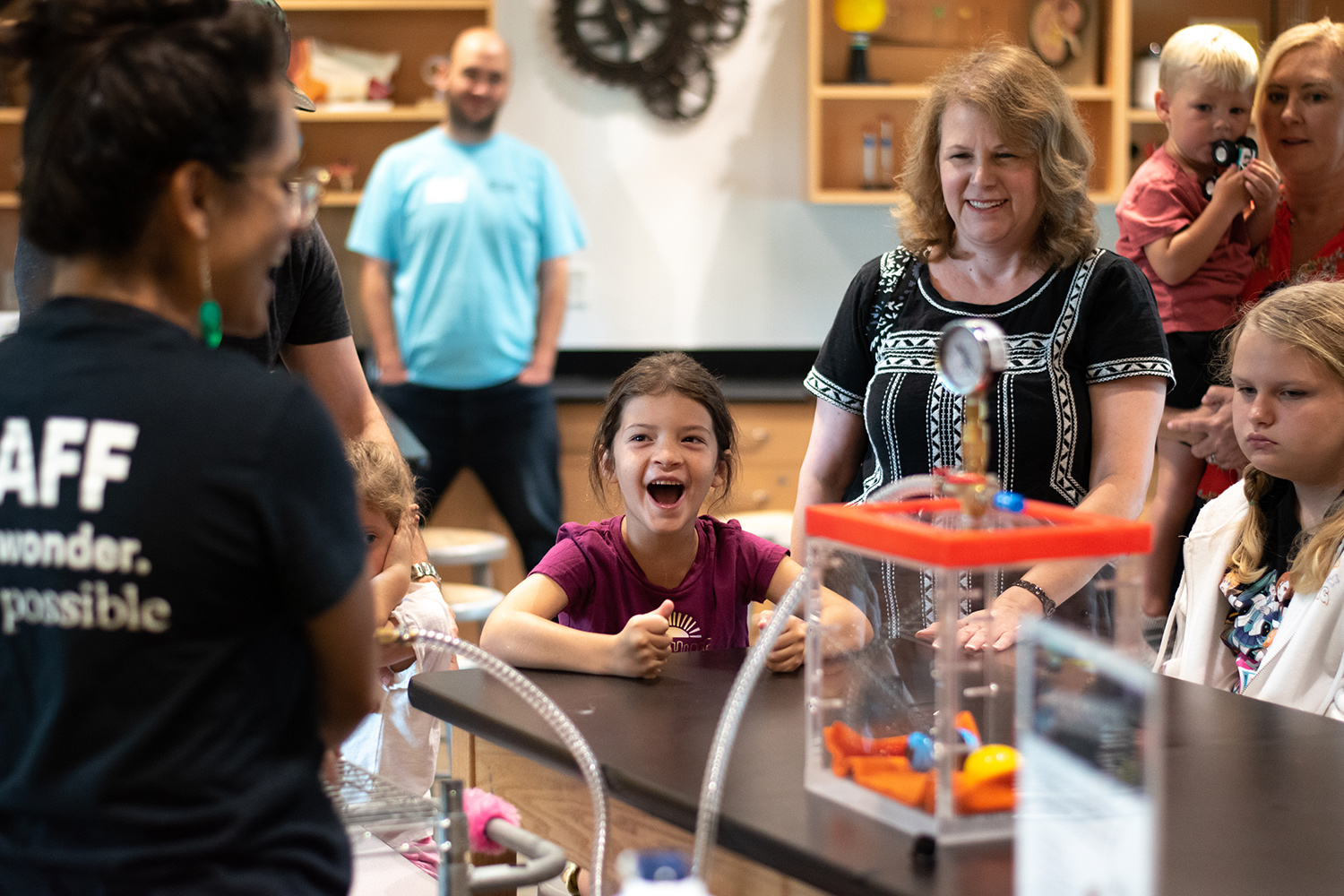
Astonished, a young child looks on as a Cade Museum staff member explains the science experiment.
(Courtesy of the Cade Museum)
An MIT Sloan study stated that innovation in the United States could quadruple if kids from low-income families, minorities, and women became inventors at the same rate as men from high-income families. The challenge, according to the study, is helping children realize their innovative potential as early as possible. Phoebe believes her museum’s outreach program can do just that. When the museum staff asks kids what they’d like to be when they grow up, many say professional athlete or entertainer. Most of them, she said, are very surprised to learn they could be innovators.
“I think, ‘How many kids out there today don't have somebody who believes in them,’” she said. “They don't have that violin teacher. They don't have the pastor. They feel like they're not a great student. What chance does that child have?”
Given the chance, however, Phoebe believes many kids who experience hardship can become the best innovators because they’re already resilient. The most successful innovators aren’t necessarily the ones who take first place.
“All of the ideas are good. Any of them could succeed,” she said. “But they're all going to face rejection — every single one. Do you give up? Do you keep on going? That to me is the predictor of success. They say don't bet on the horse, bet on the jockey.”
While 'inventivity' requires personal courage to be creative and resilient, Phoebe believes a successful invention requires a community effort. That, she says, requires the confident humility and confidence in a community to make that innovation happen.
Dr. Cade heavily depended upon a very diverse team when creating Gatorade, she said, starting with the security guard who helped inspire the idea.
“Every single one of the people in the team had a certain insight and skill set that allowed it to succeed,” she said. “It would not have happened if any one of them had not been there. For my mom, [it was] being a fabulous cook, saying ‘add lemon.’ She was a stay-at-home mom who's a good cook and added a completely new insight that all of the doctors couldn't think of. But that's so true about most inventions.”
The Gatorade name was even a team effort, she said. When discussing, and sometimes arguing, about what to call the beverage, some said it should be called “Cade’s Cola.” Phoebe said her dad listened to the ideas, but he had the final word. ‘I'm a Gator fan,'” he declared. “The name is Gatorade.”
Phoebe wants to inspire that kind of community-involved innovation across the United States.
“I really feel 'inventivity' is at the heart of ... a thriving American culture. 'Inventivity' is more American than apple pie.”
Credits
Produced by the USPTO’s Office of the Chief Communications Officer. For feedback or questions, please contact inventorstories@uspto.gov.
Story by Bill Lincicome. Additional contributions from Linda Hosler, Whitney Pandil-Eaton, Jay Premack, and Paul Rosenthal. Special thanks to Phoebe Cade Miles, Jody Farmer, Carmen Hurtado, Patty Lipka, Gwen Morgan, and Jenna Ostas.
References
Benbow, Dana Hunsinger. “The fascinating tale of Gatorade’s Indy beginnings: ’99.9% of Indiana does not know this.’” IndysStar.com, October 6, 2020. https://www.indystar.com/story/sports/2020/10/06/fascinating-tale-gatorades-indy-beginnings/5873513002/
Cade Museum. “About Our History.” https://cademuseum.org/about/history
Farmer, Jody. “13th Annual Cade Prize Winners Announced.” Business Wire, October 12, 2022. https://www.businesswire.com/news/home/20221012005803/en/
Guinness World Records. “First self-made millionairess.” https://www.guinnessworldrecords.com/world-records/first-self-made-millionairess
Linke, Rebecca. “Lost Einsteins: The US may have missed out on millions of inventors.” MIT Management Sloan School, Feb. 16, 2018. https://mitsloan.mit.edu/ideas-made-to-matter/lost-einsteins-us-may-have-missed-out-millions-inventors#:
Rogin, Gilbert. “The Bottle and The Babe.” Sports Illustrated Vault, July 1, 1968, https://vault.si.com/1968/07/01/the-bottle-and-the-babe.
Rovell, Darren. “Royalties for Gatorade Trust surpass $1 billion: ‘Can’t let it spoil us,’” ABC News.com, October 1, 2015.
https://abcnews.go.com/Sports/royalties-gatorade-trust-surpass-billion-spoil-us/story?




